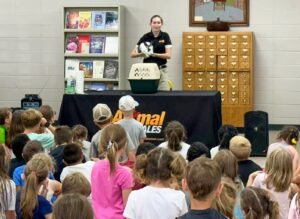Controlling parasites in horses
By Staff
Lance Bruce / 4-H Livestock agent
July 21, 2004
I started a few days ago thinking of my topic for this week's article, and I realized that most of what I write about pertains to cattle. I know that some folks may take offense to me also writing about cattle, but what can I say? I love talking about cattle.
However, I am a horseman and I need to share information with the equine community just like I do with the bovine community.
I bet if you took a survey of average horse owners and asked them what Zimecterin was, they could tell with no problem that it is a de-wormer for horses. Now ask them what parasites it controls, how long it lasts, and is there any resistance? Odds are they may not know that answer.
A parasite lives off another organism at the expense of the host. Few horses are ever free of internal parasites because horses graze. These tiny freeloaders can cause severe problems and even death if left untreated. Since these little destructive creatures can cause so much damage, it is important for horse owners to learn the signs of infestations.
A few of these parasites are common. The first is strongyles, which is a group of equine parasites that include both large and small strongyles. These invaders are often referred to as bloodworms and they occur in horses of all ages. Their life cycle is direct, meaning they have no intermediate hosts during development.
Large strongyles produce one generation per year, while the small group completes its life cycle every eight weeks. Because of the protective sheath surrounding the larvae, strongyles can endure drought and survive through winter.
The spring and fall is when the larvae become active and migrate up and down the blades of grass. The horse then grazes and is infected with the parasite. Strongyles affect the digestive system by cutting blood flow to the small intestine, colon, and cecum. The increased blood pressure can eventually lead an aneurysm. Horses that are acutely infected have fever, poor appetite, rapid weight loss, depression, colic and even death.
The horse's general body condition is exemplified by a rough hair coat and a decreased performance. With the effective use of de-wormers, the large strongyles can be dealt with. However, due to increased drug resistance it is not uncommon for horses to have small strongyles, but because of the less severe conditions of small strongyles infestation you may not even know it.
Next are roundworms, which usually affect a younger horse specifically foals and weanlings. Few adult horses have problems with roundworms because they acquire immunity to the parasite after 6 months of age. Roundworms cause liver damage along with some inflammation of the small intestine.
With a large infestation of adult roundworms the intestine can become obstructed causing the intestinal wall to rupture. A colt with roundworms will be unthrifty, have a pot-bellied appearance, loss of appetite, colic, and in very severe cases death. Roundworms are easily treated with every class of anthelmintic except phenothiazine.
Bots are very common in this area. The yellow eggs that are laid on hairs of the horse's chest and forelegs can be an easily seen infestation of the bots. When the horse licks his chest and legs he ingests the bots. Bots accumulate and attach in the stomach lining. They make pits in the stomach wall that can perforate causing peritonitis. The treatment of bots involves using organophosphates or ivermectin. The infestation can be stopped before it ever begins by clipping or scraping egg cases from the hair.
These are just a few of the internal parasites that can affect horses. Make sure to consult with your veterinarian about a deworming schedule and what products to use. He can also help you with things to do to decrease your chances of a bad infestation










